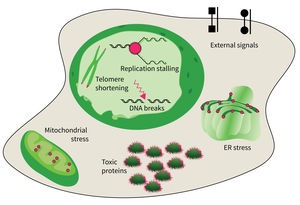Subarea 4: Cell Dynamics and Molecular Damages in Aging
The research focus of Subarea 4 is on studying damages of macromolecules (proteins, nucleic acids) and determining the structure-function relationship of biomolecules relevant to damage and damage repair processes and responses to molecular damage that might lead to aging and aging-associated pathologies.
The studies are focused on the following research areas: DNA replication, DNA damage responses (DDR), stress responses, metabolic stresses, protein trafficking and protein damages.
The research is defined by four focus areas:
- DNA damage response in tissue homeostasis and neuropathies,
- Quality control in the endoplasmic reticulum for secretory pathway in aging processes,
- Intrinsic and extrinsic factors implicated in cellular decline during aging, and
- DNA replication and genomic integrity preventing premature aging and diseases.
Research focus of Subarea 4.
The accumulation of damaged macromolecules or subcellular organelles is associated with dysfunction of a cell, which contributes to tissue & organ failure. DNA damage, genomic instability, protein misfolding or defects in toxic protein degradation can compromise cell functionality. Alterations of mitochondrial DNA and protein complexes affect cellular metabolism, which will have a general impact on cell integrity.
Publications
(since 2016)
2018
- Cystatin A suppresses tumor cell growth through inhibiting epithelial to mesenchymal transition in human lung cancer.
Ma Y, Chen Y, Li Y, Grün K, Berndt A, Zhou Z, Petersen I
Oncotarget 2018, 9(18), 14084-98 - DNA-Damage-Induced Hormetic Responses
Mägdefrau AS, Ludwig K, Weigel C, Köse N, Guerra GM, Dakhovnik A, Kosan C
In: The Science of Hormesis in Health and Longevity, Chapter 13 (edited by Suresh ISR, Marios K) 2018, 149-159, Academic Press, London - The sirtuin 1/2 inhibitor tenovin-1 induces a nonlinear apoptosis-inducing factor-dependent cell death in a p53 null Ewing's sarcoma cell line.
Marx C, Marx-Blümel L, Lindig N, Thierbach R, Hoelzer D, Becker S, Wittig S, Lehmann R, Slevogt H, Heinzel T, Wang ZQ, Beck JF, Sonnemann J
Invest New Drugs 2018, 36(3), 396-406 - Thyroid Hormone Transporters MCT8 and OATP1C1 Control Skeletal Muscle Regeneration.
Mayerl S, Schmidt M, Doycheva D, Darras VM, Hüttner SS, Boelen A, Visser TJ, Kaether C, Heuer** H, von Maltzahn** J
Stem Cell Reports 2018, 10(6), 1959-74 ** co-corresponding authors - Reduced expression of C/EBPβ-LIP extends health- and lifespan in mice.
Müller* C, Zidek* LM, Ackermann T, de Jong T, Liu P, Kliche V, Zaini MA, Kortman G, Harkema L, Verbeek DS, Tuckermann JP, von Maltzahn J, de Bruin A, Guryev V, Wang ZQ, Calkhoven CF
Elife 2018, 7, e34985 * equal contribution - The ATR-Activation Domain of TopBP1 Is Required for the Suppression of Origin Firing during the S Phase.
Sokka* M, Koalick* D, Hemmerich P, Syväoja JE, Pospiech H
Int J Mol Sci 2018, 19(8) * equal contribution - LSD1 (KDM1A)-independent effects of the LSD1 inhibitor SP2509 in cancer cells.
Sonnemann J, Zimmermann M, Marx C, Ebert F, Becker S, Lauterjung ML, Beck JF
Br J Haematol 2018, 183(4), 494-7
2017
- Toxic effects of zinc ions on kinesin - Potential molecular cause of impaired intracellular transport.
Böhm KJ
Toxicol Lett 2017, 268, 58-62 - Myofibroblasts have an impact on expression, dimerization and signaling of different ErbB receptors in OSCC cells.
Büttner R, Berndt A, Valkova C, Richter P, Korn A, Kosan C, Liebmann C
J Recept Signal Transduct Res 2017, 37(1), 25-37 - Structural Studies Revealed Active Site Distortions of Human Furin by a Small Molecule Inhibitor.
Dahms SO, Jiao** GS, Than** ME
ACS Chem Biol 2017, 12(5), 1211-6 ** co-corresponding authors









